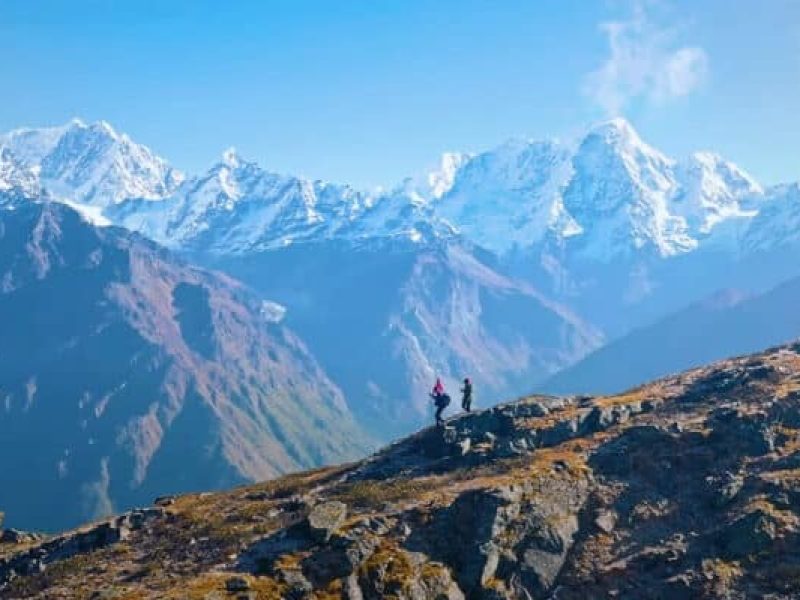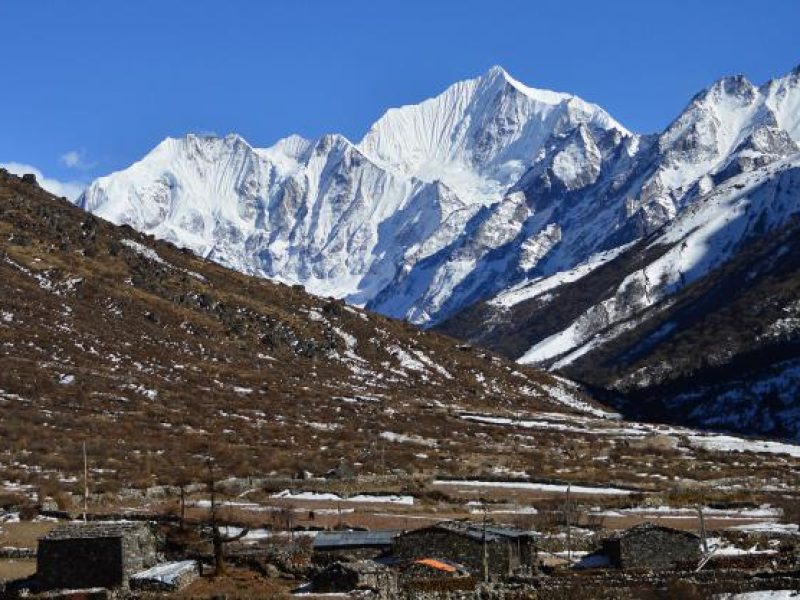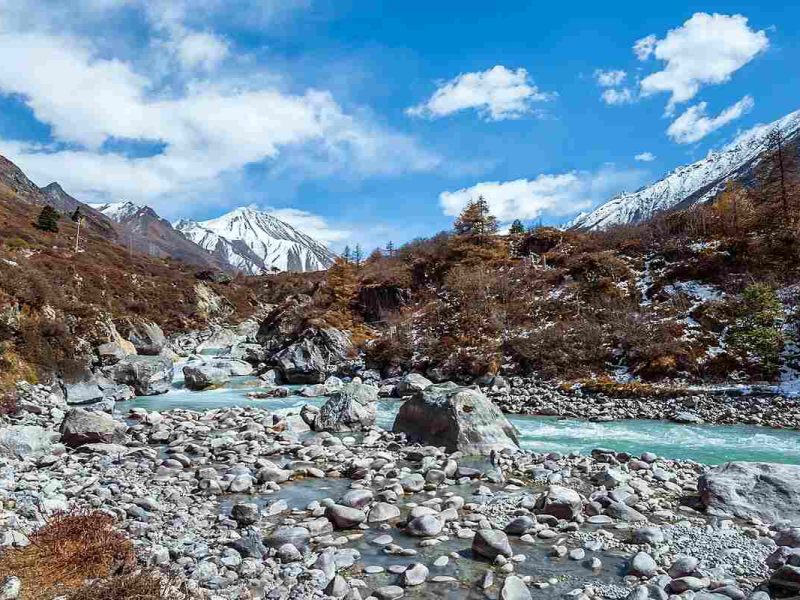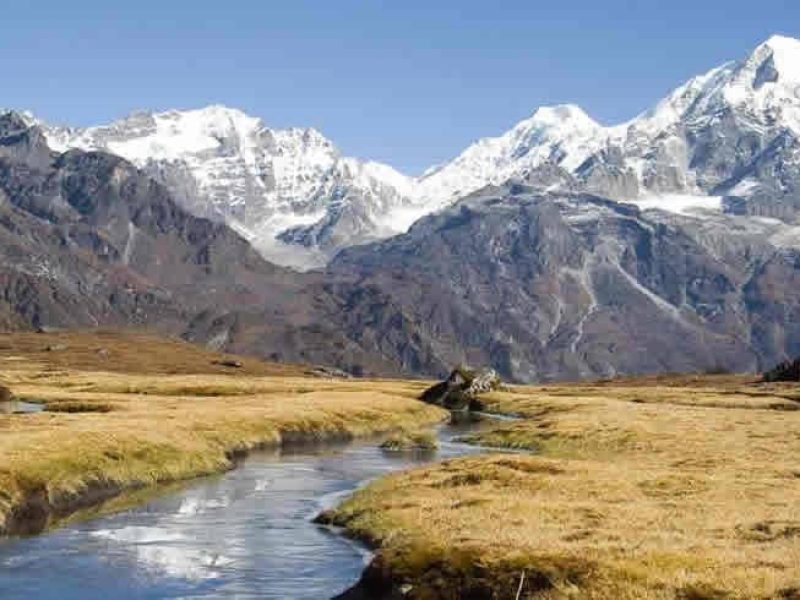Jugal Himal is a breathtaking region with untouched wilderness and towering peaks located in the Himalayas. It offers a sense of seclusion and intimacy with the wilderness with winding trails that meander through dense forests, waterfalls and streams.
The region offers a variety of outdoor activities including trekking, mountaineering, rock climbing and paragliding. The cultural heritage of the region is rich with remote villages offering glimpses into the traditional lifestyles of the indigenous communities.
It is a sanctuary for the soul offering solace in the silence of the mountains. It is a hidden gem waiting to be discovered, a place where dreams are realized and memories are made.
The Jugal Himal Trek is a hidden gem in the Himalayas offering an unparalleled opportunity to immerse oneself in the awe-inspiring grandeur of nature. The trail winds through rugged terrain crossing high mountain passes and deep valleys offers a sense of solitude and tranquility.
This region is rich in culture and tradition with remote mountain villages and monasteries offering glimpses into the spiritual heritage of the Himalayan people. The Jugal Himal Trek is a journey of self-discovery, pushing past boundaries and embracing the unknown.
Jugal Himal Nature’s Majesty
The Jugal Himal range in Nepal’s Langtang region is a stunning mountain range known for its jagged peaks, deep valleys, and picturesque alpine meadows. The range is home to a rich diversity of flora and fauna, including rare bird species like the Himalayan monal and blood pheasant and hard to find wildlife like the snow leopard and red panda.
The alpine meadows are adorned with vibrant wildflowers, while towering rhododendron trees add color to the landscape. The range offers an unforgettable experience for nature lovers and photographers seeking adventure and serenity in the Himalayas.
Preparation Tips For Jugal Himal Trek
The Jugal Himal Trek is a challenging and demanding journey through the rugged Himalayas. It is essential to maintain a moderate level of physical fitness including regular cardio exercises and strength training exercises.

Proper gear including hiking boots, warm clothing, a waterproof jacket, a comfortable backpack, a sleeping bag, trekking poles, a first-aid kit and water & snacks is very crucial for a safe and enjoyable experience.
Warm clothing such as lightweight base layers and insulating mid-layers is essential for staying warm and comfortable. A waterproof jacket with a hood is also essential for protection from rain, snow and wind. A comfortable backpack with padded straps and a hip belt is recommended for distributing weight evenly and reducing strain on the back and shoulders.
Best Time To Visit Jugal Himal
The best time to visitJugal Himal is during spring and autumn due to the ideal weather conditions and stunning scenery. Spring brings vibrant colors, mild temperatures and clear skies while autumn offers dry trails and clear skies.
The region is also a time of renewal and refreshment offering the opportunity to witness nature awakening from winter. The monsoon rains and the nights are cool and refreshing. Additionally, autumn is the season of Nepali festivals providing an opportunity to immerse oneself in the region’s rich cultural heritage.
Routes And Itinerary Options During Jugal Himal Trek
The Jugal Himal region offers various trekking routes, each with its unique charm and attractions. The Langtang Valley Trek is known for its stunning landscapes and rich cultural heritage and takes trekkers through the picturesque Langtang Valley offering breathtaking views of snow-capped peaks.
The Gosainkunda Trek, famous for its sacred alpine lakes which follows ancient pilgrimage trails to reach the sacred lakes. The Helambu Trek, renowned for its terraced fields, oak forests, and charming villages, offers a scenic journey through the Helambu region. The duration of the trek varies, with the Langtang Valley Trek lasting 7 to 10 days, the Gosainkunda Trek 9 to 12 days, and the Helambu Trek 6 to 9 days.
Accommodation Options Along Jugal Himal Trek
The Jugal Himal trekking routes offer a variety of accommodation options for trekkers. Teahouses and lodges are the most common form of accommodation offering basic yet cozy rooms with beds, blankets and basic furniture.
They also provide shared dining areas for hearty meals prepared with locally-sourced ingredients. Facilities like hot showers, joint bathrooms, shared dining areas, Wi-Fi access, charging facilities, and laundry services may be available.

For a more immersive wilderness experience camping is an option. However, it requires careful planning, observance to Leave No Trace principles and compliance with local regulations. Trekkers should also be aware of potential hazards and take appropriate precautions.
Overall, the accommodations and facilities along the Jugal Himal trekking routes contribute to a memorable and rewarding trekking experience in the breathtaking Himalayas.
Highlights Of The Jugal Himal Trek
- The Jugal Himal Trek offers stunning views of iconic Himalayan peaks like Langtang Lirung, Dorje Lakpa and Ganesh Himal amidst alpine valleys and rugged terrain.
- Trekkers witness breathtaking sunrises and sunsets amidst towering mountains adorned with pink, orange and gold hues creating a magical unforgettable spectacle.
- The Jugal Himal region offers a diverse range of wildlife including rare Himalayan species, providing an exciting adventure for trekkers.
- Trekkers can encounter rare wildlife like the red panda and the Himalayan tahr, both endemic to the region, known for their distinctive red fur and bushy tail.
- Trekkers can encounter diverse wildlife like musk deer, langur monkeys and birds in the Himalayan region offering a glimpse into the region’s rich biodiversity.
- The Jugal Himal Trek offers a captivating adventure through the Himalayas, showcasing breathtaking mountain vistas and diverse wildlife ensuring a lasting impression on its participants.
Challenges And Safety Measures During Jugal Himal Trek
Starting on the Jugal Himal Trek involves encountering various challenges inherent to trekking in high-altitude mountain terrain. To ensure a safe and fulfilling trekking experience it is essential to be aware of these challenges and take appropriate safety measures. Here’s a detailed look at two key challenges and the corresponding safety measures:
-
Altitude Sickness
Altitude sickness, or acute mountain sickness (AMS), is a prevalent concern for trekkers ascending to high altitudes. It occurs due to the reduced oxygen levels at higher elevations, leading to symptoms such as headaches, nausea, fatigue, and dizziness. The safety measures for AMS are to stay hydrated, climb gradually, listen to your body and take adequate rest and acclimatization.
-
Weather Conditions
Weather conditions in the Himalayas can be highly unpredictable, with rapid changes in temperature, precipitation, and visibility. Trekkers must be prepared to face a wide range of weather conditions during their trek. The safety measures for it are to pack accordingly, check weather forecasts and seek shelter during adverse weather.
Cultural Aspects And Local Communities Of This Himal
The Jugal Himal region is a rich cultural embroidery with diverse ethnic communities including Tamangs, Sherpas, Gurung and others. These communities share a deep connection to the land and revere the mountains surrounding them.
Trekkers can immerse themselves in the local traditions including traditional dances, music performances, and religious festivals. The region is also home to ancient monasteries and religious sites such as Tserko Ri Monastery and Kyanjin Gompa.

These sacred places attract pilgrims and travelers seeking spiritual solace. Interacting with local villagers and experiencing their hospitality is an enriching aspect of trekking in the Jugal Himal region. The mountains are not just physical landmarks but also repositories of spiritual and cultural significance.
Environmental Conservation Efforts Implemented In Jugal Himal
Preserving the delicate ecosystems of the Himalayas is crucial for ensuring the long-term sustainability of tourism and protecting the natural beauty of the region.
Here’s a detailed look at the environmental conservation efforts undertaken to safeguard the pristine landscapes of the Jugal Himal region:
1. Responsible Trekking Practice
Trekkers play a pivotal role in minimizing their environmental impact by adopting responsible trekking habits. This includes practices such as carrying reusable water bottles and avoiding single-use plastics to reduce waste generation.
Staying on designated trails helps prevent soil erosion and damage to fragile vegetation preserving the natural integrity of the landscape. Trekkers are encouraged to follow established routes and avoid creating new paths or shortcuts.
Respecting local customs and traditions fosters a harmonious relationship between visitors and local communities. Trekkers should seek permission before entering sacred sites, refraining from disturbing wildlife or livestock and adhering to cultural norms regarding dress and behavior.
2. Waste Management And Litter Control
Effective waste management is essential for maintaining the cleanliness of trekking trails and surrounding areas. Trekkers should responsibly dispose of all waste, including biodegradable and non-biodegradable items, at designated collection points.
Education programs targeting trekkers and local residents promote responsible waste disposal practices and encourage the adoption of eco-friendly alternatives.
3. Reforestation And Habitat Restoration
Reforestation projects aim to restore degraded habitats and mitigate the adverse effects of deforestation and habitat loss. Local communities, conservation organizations and governmental agencies collaborate to plant native tree species and rehabilitate degraded areas promoting biodiversity and ecosystem resilience.

Community-based conservation initiatives empower local residents to take an active role in habitat restoration efforts. By involving communities in tree planting and habitat management activities, these initiatives foster a sense of ownership ensuring the long-term success of conservation efforts.
4. Regulation And Policy Enforcement
Strict regulations and policies govern trekking activities in the Jugal Himal region with authorities implementing measures to protect sensitive ecosystems and wildlife habitats. Permit systems, park fees, and visitor quotas help manage visitor numbers and minimize human impacts on the environment.
Conclusion
In conclusion, the Jugal Himal Trek offers an unforgettable adventure in the Himalayas, showcasing breathtaking landscapes, rich cultural heritage, and diverse wildlife. Trek Me Nepal, a leading trekking agency provides expert guidance, comfortable accommodations and responsible practices. The trek offers immersive experiences such as exploring ancient monasteries and alpine meadows and contributes to the preservation of the region for future generations.
Frequently Asked Questions (FAQs)
1. How difficult is the Jugal Himal Trek?
The difficulty of the Jugal Himal Trek varies depending on the chosen route and individual fitness level. This trek is generally considered moderate and suitable for trekkers with a reasonable level of physical fitness.
2. What is the best time to undertake the Jugal Himal Trek?
The best time to begin on the Jugal Himal Trek is during the spring and autumn seasons. These months offer favorable weather conditions, clear skies and breathtaking views of the surrounding landscapes.
3. Are permits required for the Jugal Himal Trek?
Yes, trekkers required permits for trekking in the Jugal Himal region. It is advisable to check with the local authorities or trekking agencies for the latest permit requirements and regulations.
4. What kind of accommodation can I expect during the trek?
Accommodation options along the Jugal Himal Trek include teahouses, lodges and homestays in local villages for visitors. These basic yet comfortable accommodations offer meals and shelter, allowing trekkers to rest and refreshment after a day of hiking.
5. Is altitude sickness a concern during the Jugal Himal Trek?
Altitude sickness, or acute mountain sickness (AMS) is a common concern for trekkers ascending to high altitudes. To mitigate the risk of altitude-related illnesses, it is essential to ascend gradually, stay hydrated, and listen to your body. Adequate rest and acclimatization are crucial for a safe and enjoyable trekking experience.

Comment (0)